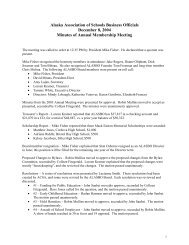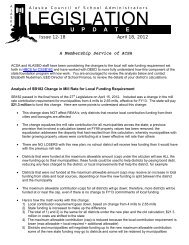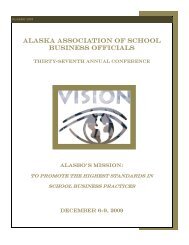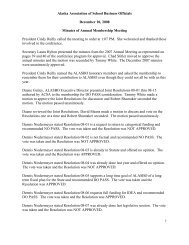PLAYGROUND SAFETY
PLAYGROUND SAFETY
PLAYGROUND SAFETY
Create successful ePaper yourself
Turn your PDF publications into a flip-book with our unique Google optimized e-Paper software.
<strong>PLAYGROUND</strong><br />
<strong>SAFETY</strong><br />
Published: January 2000
<strong>PLAYGROUND</strong> <strong>SAFETY</strong><br />
Procedures<br />
Introduction<br />
The playground is a fun-filled place. However,<br />
with the dramatic increase in playgroundrelated<br />
injuries over the past two decades, it<br />
is also a place that requires adult supervision.<br />
United States Consumer Product Safety<br />
Commission (CPSC) statistics estimate that<br />
nearly 200,000 playground-related injuries<br />
occur each year requiring emergency room<br />
visits. Nearly 40 percent of those injuries are<br />
related to inadequate supervision.<br />
Although teachers and supervisors are not<br />
expected to be trained playground inspectors,<br />
they can visually inspect the playground for<br />
safety problems and make sure that children<br />
do not play on unsafe equipment.<br />
The following tips offer key points to remember<br />
when supervising children on playgrounds.
Supervision Means...<br />
...Stay Alert and Attentive.<br />
• Move through the playground area, stationary persons only help children nearest to<br />
them. Avoid staying on outskirts of playground area.<br />
• Stay involved with the children on the playground, do not use playground time as a<br />
time for socializing with other adults or for doing paperwork.<br />
• Observe all children and the "secret" places where they could hide.<br />
• Realize a child can wander into a hazardous situation in less than a minute.<br />
• Use direct eye contact with children to help prevent inappropriate behavior.<br />
• Ensure you have an adequate number of adults supervising for the number of children.<br />
...Being Aware of Age Appropriate Equipment.<br />
• Equipment should reflect the physical, social, emotional and intellectual differences of<br />
its planned users.<br />
• All playground equipment is not appropriate for all ages of children. All KPBSD<br />
playground equipment is designed for ages 6-12.<br />
• If equipment is not labeled or separated, for specific ages, direct children to equipment<br />
appropriate to their ages and development.<br />
...Evaluating Hazards.<br />
• Evaluate the playground for potential hazards that could cause serious or fatal injuries<br />
to children.<br />
• Watch for foreign objects such as glass, nails, and pop tops that are hard to see.<br />
• Ensure all animal feces are removed from area.<br />
• Watch for hazards like loose or protruding nuts or bolts, broken parts, exposed<br />
concrete, and shallow protective surfacing that occur through the children's regular use<br />
of equipment.<br />
• Surface material should be no larger than 1/2" material.<br />
• If you spot problems that you can remedy yourself, like picking up trash, correct the<br />
problem. If you observe other safety problems like broken equipment, or inadequate
amount of surfacing material, contact the administrator and request that it be fixed, or<br />
taken out of service.<br />
• Children's clothes should be inspected for safety. Remove any loose clothing, hoods or<br />
strings that might catch on playground equipment.<br />
• Equipment that is deemed a safety issue should be taken out of service immediately.<br />
...Observing.<br />
• Keep an eye out for any unsafe behavior such as climbing up a slide or sliding down a<br />
slide backwards.<br />
• Make sure children keep moving on equipment and keep their hands and feet on<br />
supports at all times.<br />
...Knowing Safe Playground Rules.<br />
• Teach children the safety rules of the playground.<br />
• Agree on rules before children are allowed on equipment to prevent confrontations on<br />
the playground.<br />
• Realize school age children can remember up to five rules, while preschoolers should<br />
have only three or less.<br />
• Remind children that they are never to leave the playground area without permission<br />
from a supervising adult.<br />
• Instruct children to keep their hands to themselves-no hitting, pushing, punching,<br />
kicking or biting.<br />
• No sand throwing<br />
• Snow stays on the ground. Prohibit throwing of snowballs.<br />
... When Inappropriate Behavior Occurs …<br />
• Warn children verbally about inappropriate behavior; intervene between fighting<br />
children immediately to prevent injury.<br />
• Enforce rules firmly and consistently; Pushing, throwing objects, and hitting other<br />
children can lead to serious injury.<br />
• Reinforce safe playground behavior on public playgrounds by following through with<br />
appropriate measures.<br />
...Being Prepared.<br />
• Keep a first aid kit stocked and easily available in case an injury occurs.<br />
• First aid kits should be maintained by nurse/office staff and include latex gloves.<br />
• Try to ensure at least one playground supervisor is certified in first aid and CPR.
Pieces of Equipment Most Likely to be Associated with Injuries<br />
Type of Injury<br />
Equipment Total<br />
Victim 6<br />
Climbers 32% 18% 40%<br />
Slides 29% 43% 21%<br />
Swings 26% 22% 28%<br />
See-saws 6% 7% 5%<br />
Other 7% 10% 6%<br />
Most Common Injuries by<br />
Hazard<br />
Falls to surface 58.10%<br />
Falls, other 16.50%<br />
Impact, moving<br />
equipment<br />
13.10%<br />
Other 6.90%<br />
Impact, static<br />
equipment<br />
5.40%<br />
Injuries by Type of Equipment<br />
Climbers 31.90%<br />
Slides 29.10%<br />
Swings 26.00%<br />
See-saws 6.00%<br />
Merry-gorounds<br />
3.60%<br />
Other 3.40%<br />
Statistics from 1996 National Parks and Recreation Association's National Playground Safety Institute.
Playground Accident Procedures<br />
If an accident occurs on the playground, the following procedures should be<br />
followed:<br />
1. Keep other children away from the area.<br />
2. Check for injuries and secure proper medical assistance.<br />
3. Always suspect a neck and back injury with head injuries, until proven otherwise.<br />
4. DO NOT MOVE THE STUDENT IF YOU HAVE ANY DOUBTS. However, if the injury is not<br />
of a serious nature, help the student to the clinic or office.<br />
5. If the accident is due to defective equipment, make sure that the other students stay away<br />
from the equipment until it is repaired or replaced.<br />
6. Notify the administrator of defective equipment.<br />
7. Obtain the names of all witnesses.<br />
8. Complete a "Report of Accident" as soon as possible if:<br />
• Student left school or activity for medical treatment<br />
• Ambulance is called<br />
• Parent was notified<br />
• Injury involves weather conditions<br />
• Injury may have been caused by physical condition of facility.<br />
• Injury involves the head, neck, or spine<br />
• Injury was competitive sports related<br />
If the form is to be filled out by the school nurse, be sure you obtain all of the necessary<br />
information in order for the form to be filled out completely.<br />
9. Send COMPLETED form to the Planning and Operations Department.<br />
10. If equipment is determined to be a safety issue, have administrator contact the Risk<br />
Management Department for repair. Secure defective equipment and take pictures if a major<br />
injury has occurred. Phone the Risk Manager at (907) 262-8612.<br />
The following form is available at all schools. Please be sure to use the current<br />
version and fill in all information as completely and accurately as possible.
KENAI PENINSULA BOROUGH SCHOOL DISTRICT<br />
STUDENT INJURY/INCIDENT REPORT<br />
1. Student's Name__________________________________<br />
Student ID#____________D.O.B._______________Male [ ] Female [ ]<br />
School_____________________________________________________________<br />
Grade___________<br />
Father's Name___________________________________<br />
Mother's Name______________________________________________<br />
Home Address_______________________________________________________<br />
Phone Number___________________<br />
2. Date of injury/incident______________________________<br />
Time of injury/incident______________________________<br />
3. Location where injury/incident occurred:<br />
[ ] Bus/bus stop [ ] Cafeteria [ ] Chemistry lab. [ ] Classroom<br />
[ ] Football field [ ] Gym [ ] Hallway [ ] Home Economics<br />
[ ] Ice Rink [ ] Locker room [ ] Parking lot [ ] Play ground<br />
[ ] Restroom [ ] School grounds [ ] Shop-Wood/Auto [ ] Stairs<br />
[ ] Other:_______________________________________________<br />
4. Type of injury:<br />
[ ] Abrasion [ ] Amputation [ ] Burn [ ] Laceration [ ] Puncture [ ] Scratches<br />
[ ] Poss. Concussion [ ] Poss. Dislocation [ ] Poss. Fracture<br />
[ ] Poss. Sprain [ ] Other:____________<br />
5. Part of body injured: (indicate right by R and left by L on the item checked, when<br />
appropriate)<br />
[ ] Scalp [ ] Head [ ] Face [ ] Eye R L [ ] Nose<br />
[ ] Mouth [ ] Tooth [ ] Neck [ ] Chest [ ] Arm R L<br />
[ ] Elbow R L [ ] Hand R L [ ] Wrist R L [ ] Finger R L [ ] Abdomen<br />
[ ] Back [ ] Leg R L [ ] Knee R L [ ] Foot R L [ ] Ankle R L<br />
[ ] Other:____________________________<br />
6. Activity student involved in at the time of the incident and cause of injury: (be specific about<br />
event resulting in injury)
7. Description of incident by supervisor: Describe how the accident happened, what the<br />
student was doing, location of the student, unsafe acts and/or conditions, and specific<br />
safeguards used & amount of supervision.<br />
8. Description of injury/incident by the injured student:<br />
9. Description of injury/incident by witness: (include the name of the witness)<br />
10. Description of first aid given by supervisor/teacher (other than by nurse-Section 10 is to be<br />
completed by the nurse)<br />
11. Disposition:<br />
[ ] Home [ ] Physician [ ] Emergency room [ ] Returned to class [ ] Other:<br />
(explain)_________________________________________________________<br />
12. Who was notified:<br />
[ ] Mother [ ] Father [ ] Guardian [ ] Emergency contact [ ] Other:<br />
(explain)_________________________________________________________<br />
13. Notification made by:<br />
[ ] Telephone [ ] Note: File a copy in the student's cum. Health folder.<br />
14. Student transported to:<br />
[ ] Home [ ] Physician [ ] Emergency Room [ ] Other:<br />
(explain) _________________________________________________________<br />
Time: _________________<br />
15. Student transported by: [ ] Parent [ ] Ambulance<br />
[ ] Other:_______________________________________<br />
16. Additional follow-up:<br />
____________________________________________________________________________<br />
This Section to be completed by the school nurse, if directly involved in providing emergency<br />
care.<br />
(Be sure to include follow-up notation, especially when not available for emergency care).
17. NURSES ACTION: Time/Date___________________ Nurse Available [ ] Yes [ ] No<br />
(Subjective) Student states:<br />
(Objective) B/P__________P__________R__________<br />
(Assessment)<br />
(Plan)<br />
(Please Print)<br />
Form Completed by:<br />
_________________________________________________________Date_______________<br />
Teacher or Supervisor:<br />
_________________________________________________________Date_______________<br />
School Nurse:<br />
_________________________________________________________Date _______________<br />
Principal:<br />
_________________________________________________________Date _______________<br />
Original To: School District Copies To: School Office and School Nurse D 101 Rev. 01/2000
Common Playground Equipment Dangers<br />
"S" Hooks: Open-ended hooks, especially the "S" hooks<br />
on swings that can catch skin or clothing, should be<br />
avoided. Contact Maintenance to close open "S" hooks.<br />
Exposed Screws and Bolts: Most sets include protective<br />
caps to cover screws and bolts. When protective caps are<br />
not in place, tape over all exposed screws and bolts,<br />
including those that appear to be out of the reach of the<br />
children. Call Maintenance for repair.<br />
Sharp Edges: Some sets have sharp edges on points<br />
where the parts fit together. Tape over these areas with<br />
heavy tape and call Maintenance for repair.<br />
Improper Anchoring: Support legs can be set in<br />
concrete for stability. All types of anchoring devices<br />
should be buried below ground level to avoid a tripping<br />
hazard or a hard fall.<br />
Inadequate Surfacing: Keep surfaces underneath<br />
swings and slides even and with a minimum depth of 6<br />
inches. Keep surfaces raked to fill in holes.<br />
Protruding Wire: Serious injures can result from exposed<br />
wire from broken fences and backstops. Wire should be<br />
bent back or cut so that the edge is not exposed. Call<br />
Maintenance.<br />
Splintering: Wooden logs, due to weathering, can result<br />
in the wood splintering. Report splintered wood to<br />
maintenance.
Playground Usage Guidelines<br />
The following information is designed to provide you with some assistance in the development<br />
of safe and appropriate guidelines for activities on school playgrounds.<br />
General Safety Rules<br />
1. All games should be approved and played in appropriate areas.<br />
2. Any danger areas on the playground should be so designated. These danger areas may<br />
include, for example, a softball diamond if a game is in progress. Children should be instructed<br />
to stand clear of these danger areas and the participants in the softball game should also be<br />
given safety instructions including "Do not throw the bats!"<br />
3. All games should be appropriate to the grade level of the participants.<br />
4. All playground activities must be supervised.<br />
5. The best safety policy is good construction and instruction!<br />
6. No tackle football, ice hockey or other high hazard sports during recess.<br />
General Apparatus Guidelines<br />
1. Do not carry objects while climbing on equipment.<br />
2. Bars and rings are for children who can reach them without help.<br />
3. At least one hand must be in contact with the apparatus at all times. Hands are the last part<br />
of the body to leave the apparatus.<br />
4. Apparatus should be dry when in use.<br />
5. Children should be taught to hang and drop, bending the knees upon landing, as the proper<br />
method to dismount from the apparatus.<br />
6. Do not sit on the apparatus.<br />
7. Do not play under the apparatus.<br />
8. Use warm water to release skin from metal during freezing temperatures.
Rings<br />
1. Rings are to be used for "traveling";<br />
never for acrobatic gymnastic stunts.<br />
2. One child must get half way around<br />
before a second child starts.<br />
3. Only one child should be on the<br />
approach board at a time.<br />
4. Children should drop from ring to sand<br />
or approved surface below when their turn<br />
is completed. They should not swing out<br />
over the blacktop or other concrete surfaces and release their grip.<br />
Bars<br />
1. Grasp the bars with both hands. Use<br />
overhand, reverse, or mixed grip.<br />
2. Pull-ups, chin-ups, and twining the body<br />
over the bar are good conditioning<br />
activities.<br />
3. Never stand on bars or attempt to jump<br />
off.<br />
Jungle Gym/Climbers<br />
1. Never hang by the knees, stand on the<br />
top, or jump from the jungle gym.<br />
2. Children should have both hands in<br />
contact with the jungle gym and should<br />
not interfere with other children while<br />
climbing.
Horizontal Ladder<br />
1. Travel on the ladder should proceed in<br />
the same line of direction.<br />
2. One child should be halfway across<br />
before a second child starts.<br />
3. Children should not sit or stand on top<br />
of the ladder.<br />
Slides<br />
1. Climb up the ladder, one step at a time<br />
and one child at a time.<br />
2. Slide down in a sitting position, feet<br />
forward.<br />
3. No straddling slide, going down<br />
backwards, or on side.<br />
4. Bottom should remain on slide at all<br />
times.<br />
5. Metal slides should be check to assure<br />
a safe surface temperature during hot<br />
weather.<br />
Geodesic Domes<br />
1. Use should be restricted to fourth grade<br />
and higher.<br />
2. Games such as "chase", "tag," and<br />
"train" should not be permitted.<br />
3. Children should not play on the surface<br />
under the dome.<br />
4. You should have at least three body<br />
parts in contact with the dome at all times,<br />
such as two arms and one leg.
Bats and Balls<br />
1. Volleyballs and basketballs are not to<br />
be kicked.<br />
2. Bat handles are to be taped. Bats must<br />
be checked for cracked or worn places.<br />
3. Bats are not to be swung except in<br />
approved areas.<br />
4. Bats are not to be thrown. (Show<br />
students the proper way to drop the bat<br />
before running the bases.)<br />
5. Persons catching or umpiring behind<br />
the batter should wear masks.<br />
Swings<br />
1. Children must maintain a sitting position<br />
while the swing is in motion. No jumping<br />
from swing while it is in motion.<br />
2. There should be only one child per<br />
swing.<br />
3. Motion of the swing should only be<br />
forward or backward. No twisting or<br />
twirling.<br />
4. Peers should not play near swings<br />
when they are in motion.<br />
Tire Swings<br />
1. Children must maintain a sitting position<br />
while the swing is in motion. No jumping<br />
from swing while it is in motion.<br />
2. There should be only one child per<br />
swing.<br />
3. Peers should not play near swings<br />
when they are in motion.<br />
4. Report defects to Maintenance<br />
immediately.
Suggestions for Playground Supervisors<br />
1. Everyone connected with the school (teachers, aides, visitors, recreation leaders, etc.) should<br />
follow the same safety rules.<br />
2. Assemblies on safety are extremely beneficial. These should be scheduled on a periodic<br />
basis to review any new playground equipment and any new playground guidelines that are to<br />
be implemented.<br />
3. Walk the class through a safety course on the playground the first day of the school year.<br />
4. Remember; the best safety policy is good supervision and instruction, as well as constant<br />
review of playground guidelines and rules.<br />
Changes or Additions to Playgrounds<br />
Schools do not have the authority to independently perform alterations, modifications, upgrades<br />
or maintenance to their playground equipment without first coordinating with Risk Management.<br />
Additional playground equipment must be acquired from an approved vendor, with Risk<br />
Management approval.<br />
Safety Concerns or Issues<br />
The Kenai Peninsula Borough School District strives to maintain safe playgrounds for the<br />
students. If you have safety concerns that cannot be addressed through the facility<br />
administrator, please call Risk Management at (907) 262-8612.
Wind Chill Factor...<br />
Wind Chill refers to the evaporation of moisture from exposed skin. Wind Chill Factor, is a<br />
measure of the cooling effect of wind. In cold weather a person loses more heat when the wind<br />
is blowing than when it is calm.<br />
Equivalent Wind Chill Temperatures*<br />
To determine wind chill, find the outside air temperature on the top line, then read down the<br />
column to the measured wind speed (MPH - Miles Per Hour.) For example: When the outside<br />
air temperature is 0 degrees F, and the wind speed is 20 MPH the rate of heat loss is equivalent<br />
to minus 39 degrees F when there is no wind (zero up to 4 mph.)<br />
The area shown in green corresponds to Little Danger. The area shown in yellow corresponds<br />
to Increasing Danger where flesh may freeze within 1 minute. The area show in red<br />
corresponds to great danger where flesh may freeze within 30 seconds.<br />
* National Weather Service<br />
The following information reflects current guidelines for the Kenai Peninsula Borough School District and<br />
restates a 1991 discussion concerning cold weather recess:<br />
Periods of prolonged outdoor time for students should not occur when the temperature is -10<br />
degrees Fahrenheit or below. This figure should include a wind chill factor. Prolonged outdoor<br />
activities are, recess, PE, class walks, etc. When applying this guideline, please take into<br />
consideration the medical needs of children with special conditions or who are recuperating<br />
from illness.<br />
Helpful telephone numbers for temperature information on the Kenai Peninsula are 262-6500<br />
and 235-6101.<br />
Examples:<br />
28 degrees - Conditions comfortable when properly dressed.<br />
18 degrees - Conditions no longer pleasant for outdoor activities on overcast<br />
days<br />
9 degrees - Conditions no longer pleasant for outdoor activities on sunny<br />
days.<br />
1 degree - Freezing of exposed skin begins for most people depending on<br />
the degree of activity and the amount of sunshine<br />
-31 degrees - Conditions for outdoor travel, such as walking, become<br />
dangerous. Exposed areas freeze in less than one minute for<br />
the average person.<br />
-50 degrees - Exposed flesh freezes within a half minute on the average.
Produced by<br />
Planning and Operations<br />
Kenai Peninsula Borough School District<br />
With the cooperation of:<br />
Risk Management Department<br />
Denver Public Schools<br />
Playgrounds Regulated By<br />
Kenai Peninsula Borough<br />
144 N. Binkley Street<br />
Soldotna, AK 99669<br />
Risk Manager<br />
Gary Lamb<br />
(907) 262-8612<br />
A Safe Place to Learn and Work







